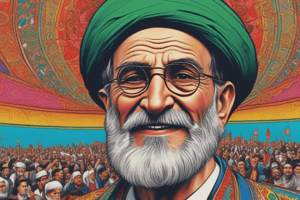Podcast
Questions and Answers
What is the primary reason for the occurrence of the Islamic Revolution, according to the text?
What is the primary reason for the occurrence of the Islamic Revolution, according to the text?
The primary reason for the Islamic Revolution was the unsatisfactory cultural situation in society, which led to political dissatisfaction.
The text states that the Islamic Revolution was similar to other revolutions in its focus on cultural and identity-based issues.
The text states that the Islamic Revolution was similar to other revolutions in its focus on cultural and identity-based issues.
False (B)
What is the primary characteristic of the Islamic Revolution?
What is the primary characteristic of the Islamic Revolution?
- Political
- Cultural (correct)
- Social
- Economic
Imam Khomeini viewed the Islamic Revolution as primarily a political transformation.
Imam Khomeini viewed the Islamic Revolution as primarily a political transformation.
What is the significance of the slogan 'No to East, No to West' according to the text?
What is the significance of the slogan 'No to East, No to West' according to the text?
What was the primary goal of the Islamic Revolution regarding the Iranian government?
What was the primary goal of the Islamic Revolution regarding the Iranian government?
What is the main difference between the two types of 'westernized' models used in Iran during the early 20th century?
What is the main difference between the two types of 'westernized' models used in Iran during the early 20th century?
What was the primary goal of the 'westernized' model that promoted a complete break from Islamic values?
What was the primary goal of the 'westernized' model that promoted a complete break from Islamic values?
What was the main outcome of the tobacco protest in the late 19th century in Iran?
What was the main outcome of the tobacco protest in the late 19th century in Iran?
What was the goal of the 'Justice House' movement?
What was the goal of the 'Justice House' movement?
The text states that the 'Justice House' movement was successful in achieving its goals.
The text states that the 'Justice House' movement was successful in achieving its goals.
What was the main contributing factor to the rise of Reza Shah, according to the text?
What was the main contributing factor to the rise of Reza Shah, according to the text?
What were the two main policies that Reza Shah implemented to modernize Iran?
What were the two main policies that Reza Shah implemented to modernize Iran?
The text mentions that during Reza Shah's reign, the people of Iran fully adopted Western ideas and practices.
The text mentions that during Reza Shah's reign, the people of Iran fully adopted Western ideas and practices.
What was the main ideological difference that fueled opposition to Reza Shah?
What was the main ideological difference that fueled opposition to Reza Shah?
What were the two main reasons for the failure of the Iranian government to achieve its modernization goals during the Pahlavi era?
What were the two main reasons for the failure of the Iranian government to achieve its modernization goals during the Pahlavi era?
What was the main event that led to the intensification of the Islamic Revolution's momentum, according to the text?
What was the main event that led to the intensification of the Islamic Revolution's momentum, according to the text?
What were the two main elements that propelled the Iranian people into action against the Shah's regime?
What were the two main elements that propelled the Iranian people into action against the Shah's regime?
The text states that the Islamic Revolution was primarily a spontaneous uprising of the Iranian people.
The text states that the Islamic Revolution was primarily a spontaneous uprising of the Iranian people.
What was the main theme driving the Iranian people's longing for change during the Pahlavi era, according to the text?
What was the main theme driving the Iranian people's longing for change during the Pahlavi era, according to the text?
What were the three main groups that contributed to the eventual overthrow of the Shah's regime?
What were the three main groups that contributed to the eventual overthrow of the Shah's regime?
What was the main focus of Imam Khomeini's message during the Islamic Revolution, according to the text?
What was the main focus of Imam Khomeini's message during the Islamic Revolution, according to the text?
The text states that the Islamic revolution led to a period of complete peace and stability in Iran.
The text states that the Islamic revolution led to a period of complete peace and stability in Iran.
What was the primary reason for the downfall of the Pahlavi regime, according to the text?
What was the primary reason for the downfall of the Pahlavi regime, according to the text?
The text suggests that the Islamic Revolution was purely a domestic movement within Iran, with no external influences.
The text suggests that the Islamic Revolution was purely a domestic movement within Iran, with no external influences.
What were the two main aspects of the Islamic Revolution's impact on the international stage, according to the text?
What were the two main aspects of the Islamic Revolution's impact on the international stage, according to the text?
Flashcards
What is a social revolution?
What is a social revolution?
Revolution is a complete change in the fundamental structure of a society, impacting political, economic, social, and cultural aspects, often through violent upheaval.
What is a political revolution?
What is a political revolution?
It's a significant change in the political structure of a nation, aiming to replace the current ruling power with a new government. The goal is to alter political systems while leaving the existing social structure largely intact.
What is a coup d'état?
What is a coup d'état?
A forceful seizure of power, usually undertaken by a group within the military, often lacking widespread public support.
What is a reform movement?
What is a reform movement?
Signup and view all the flashcards
What is a riot?
What is a riot?
Signup and view all the flashcards
What is a social movement?
What is a social movement?
Signup and view all the flashcards
What is an ideology?
What is an ideology?
Signup and view all the flashcards
What is revolutionary spirit?
What is revolutionary spirit?
Signup and view all the flashcards
What is a revolution's guiding ideology?
What is a revolution's guiding ideology?
Signup and view all the flashcards
What is revolutioary leadership?
What is revolutioary leadership?
Signup and view all the flashcards
What is revolutionary mobilization?
What is revolutionary mobilization?
Signup and view all the flashcards
What is the revolutionary period?
What is the revolutionary period?
Signup and view all the flashcards
What is the post-revolutionary period?
What is the post-revolutionary period?
Signup and view all the flashcards
What is modernization?
What is modernization?
Signup and view all the flashcards
What is a theocracy?
What is a theocracy?
Signup and view all the flashcards
What is secularism?
What is secularism?
Signup and view all the flashcards
What is state-building?
What is state-building?
Signup and view all the flashcards
What is nationalism?
What is nationalism?
Signup and view all the flashcards
What is ethnic nationalism?
What is ethnic nationalism?
Signup and view all the flashcards
What is the Industrial Revolution?
What is the Industrial Revolution?
Signup and view all the flashcards
What is the Age of Imperialism?
What is the Age of Imperialism?
Signup and view all the flashcards
What is Westernization?
What is Westernization?
Signup and view all the flashcards
What is absolute monarchy?
What is absolute monarchy?
Signup and view all the flashcards
What is decolonization?
What is decolonization?
Signup and view all the flashcards
What is the Iranian Revolution of 1979?
What is the Iranian Revolution of 1979?
Signup and view all the flashcards
What is humanism?
What is humanism?
Signup and view all the flashcards
What is a 'Imam'?
What is a 'Imam'?
Signup and view all the flashcards
What is a 'Marja'?
What is a 'Marja'?
Signup and view all the flashcards
Why is the Iranian Revolution of 1979 considered a social revolution?
Why is the Iranian Revolution of 1979 considered a social revolution?
Signup and view all the flashcards
Is the Iranian Revolution of 1979 considered a success?
Is the Iranian Revolution of 1979 considered a success?
Signup and view all the flashcards
Study Notes
Key Points of Various Chapters
- Chapter 1: Revolution and Change
- Revolution defined as a profound change, transformation, and return.
- Revolution is a political action intended to overthrow the existing system and establish a new government.
- Scholars categorized revolutions into political and social revolutions.
- Political revolutions concentrate on altering the political structure, while social revolutions affect the economic, social, and political fabric of society.
- A revolution differs from a coup d'état, which is a military seizure of power, and a protest movement, which can lead to either reform or revolution.
- Four factors are essential for a revolution: deep societal dissatisfaction (political, social, economic, and cultural), the emergence of new ideologies, the spread of revolutionary sentiment, and capable leadership (individual or collective).
- Chapter 2: Historical Context of Iranian Revolution
- 18th and early 19th centuries witnessed significant industrial transformations in Europe, leading to increased demand for raw materials from regions like the Middle East.
- The decline of the Ottoman Empire weakened the global power of Muslims.
- Qajar rulers, with an autocratic governance style, led to severe social, political, and economic crises in Iran.
- Interaction with European cultures exposed societal challenges.
- These exchanges prompted the rise of dual responses: a Westernizing and an Islamic revivalist trend.
- Chapter 3: Events Leading to and Influencing Islamic Revolution
- Russian and British interventions in Iranian affairs, exacerbating existing economic and political crises, contributed to the revolution's roots.
- The Qajar dynasty faced conflicts with foreign powers over resources.
- Notable figures like Amir Kabir, Qavam al-Mulk, and Mirza Hoseyn Khan Sepahsalar attempted domestic reforms.
- The Tobacco Protest (1270) and the Constitutional Revolution represented significant opposition to external and internal oppression.
- The Constitutional Revolution, though initially aimed at reform, faced internal divisions and external interference.
- Chapter 4: Pahlavi Era and its Ideology
- The Pahlavi dynasty's ideology—a blend of archaism, modernism, and secularism—was often inconsistent.
- The Pahlavi regime implemented policies aimed at modernization, yet met resistance due to cultural and religious differences.
- Reforms aimed at abolishing traditional values, like the veil, encountered significant opposition from religious leaders and the public.
- The regime's secular policies met resistance from religious and cultural groups.
- Chapter 5: Evolution of the Islamic Revivalist Trend
- The evolution of Islamic revivalism predates the Pahlavi era, with roots in the Constitutional Revolution and the criticisms of Westernization.
- The rise of the concept of an Islamic government played a major role in shaping the revolutionary movement.
- Religious leadership (especially Ayatollah Khomeini and his followers) played a significant role in mobilizing public support for the cause of religious governance.
- Chapter 6: Nature of the Islamic Revolution
- The Islamic revolution was described as an intellectual and identity seeking movement.
- It significantly contrasted with other revolutions in nature and focus.
- Ayatollah Khomeini considered it a cultural change.
- Chapter 7: Achievements of the Islamic Revolution
- Internal achievements: The overthrow of the monarchy and the establishment of an Islamic government; enhanced public participation in politics; and reformed foreign policy.
- External achievements: Influence on global political and cultural dynamics; promotion of religious values; and support for liberation movements.
- Chapter 8: Gainings of Revolution
- Cultural achievements: Rejection of Western cultural practices; improved education and intellectual levels; and increased female empowerment.
- Social achievements: Increased human rights and judicial system fairness; promotion of Islamic brotherhood; establishment of consistent governance.
Studying That Suits You
Use AI to generate personalized quizzes and flashcards to suit your learning preferences.




